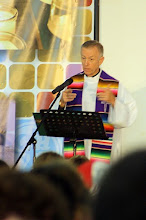This past Wednesday, 25 January, Pope Benedict XVI presided at a Vespers (Evening Prayer) service in the Basilica of Saint Paul Outside the Walls, to mark the end of this year’s Week of Prayer for Christian Unity.
And on Saturday, 10 March, he will again preside at a Vespers service, this time at San Gregorio al Celio (just up from the end of the Circus Maximus), in context of a visit from the Archbishop of Canterbury.
Why these two churches?
For centuries, St Paul’s has had a special association with the Church in England (long before the Reformation). The King of England was an honorary member of the Chapter (the decision-making body) of the Benedictine monks in whose care the basilica rests; the Abbot of the community was, in return, an honorary Knight of the Garter. Needless to say, by the 1530s this relationship of mutual honor was all but destroyed.
But because of this heritage, and because of the ways in which the Catholic Church and the Church of England were working together in ecumenical dialogue in the post-Vatican II era, historical associations seemed good to be remembered if not restored. And in the past the Bishop of Rome and the Archbishop of Canterbury shared the sanctuary for this final prayer service. Of course the fact that Christian Unity Week ends on the Feast of the Conversion of St Paul made the choice of this basilica even more obvious.
San Gregorio has a complex of wonderful associations of its own. Its site originally was a monastic-style community founded on his family’s estate by the man who became Pope Gregory the Great (late 6th century). And it was from this community that he sent missionaries to England to preach to the Angles and Saxons there (we must always remember that Christianity in Britain pre-dates this event—there were Roman British and Celtic Christians centuries beforehand). Still, under the leadership of St Augustine (who became the first archbishop of Canterbury), the Good News spread in England. It also set up a conflict with the earlier Celtic Church, but this is a story best left for another time (and, in fact, by St Bede the Venerable). So if you like, Archbishop Rowan Williams will be returning to the threshold of his ecclesiastical patrimony (if you like, making a personal ad limina visit) of sorts).
The complex of buildings directly behind this church now serves as the international motherhouse of the Missionaries of Charity; there the sisters offer food and lodging for the homeless poor (and I worked there one evening a week during one of my years in seminary). It is only here (or Calcutta) that Mother Teresa’s sisters make their solemn final vows.
What comes of such prayerful encounters as these? What kind of conversation might the Pope and the Archbishop have? Where might it lead? When we speak with divided voices, what I hear is a line from many old cowboy movies: “Paleface speak with forked tongue.” Can our voices unite? Here are the questions that need real answers…
[Footnote: There is one other church very important especially to English Catholics, and it is San Giorgio in Velabro,
a small church near to the more famous church of Santa Maria in Cosmedin (which houses on its front porch the legendary Bocca della Verità). San Giorgio was named for a saint who was (and is) one of the patrons of England; and it was given as a “titular church” in 1879 to John Henry Newman when Pope Leo XIII made him a Cardinal. Needless to say, this is an association very dear to my own heart!]




No comments:
Post a Comment